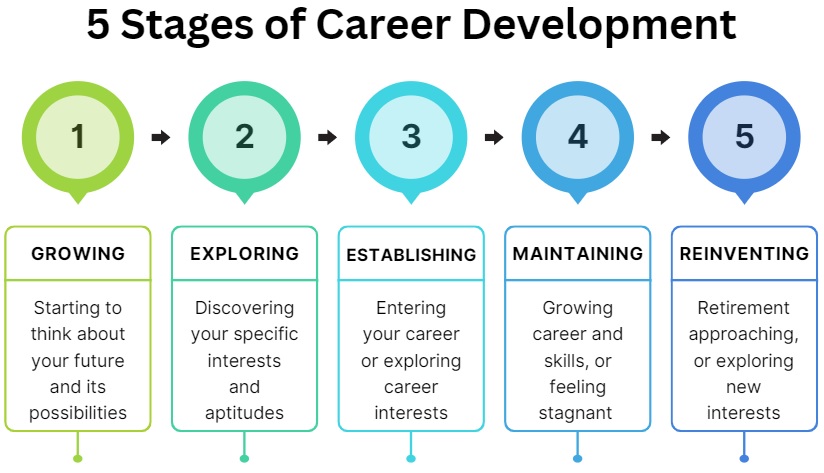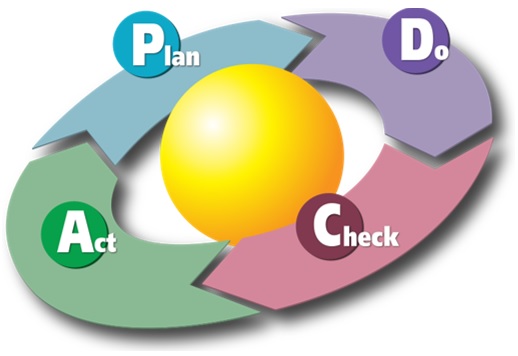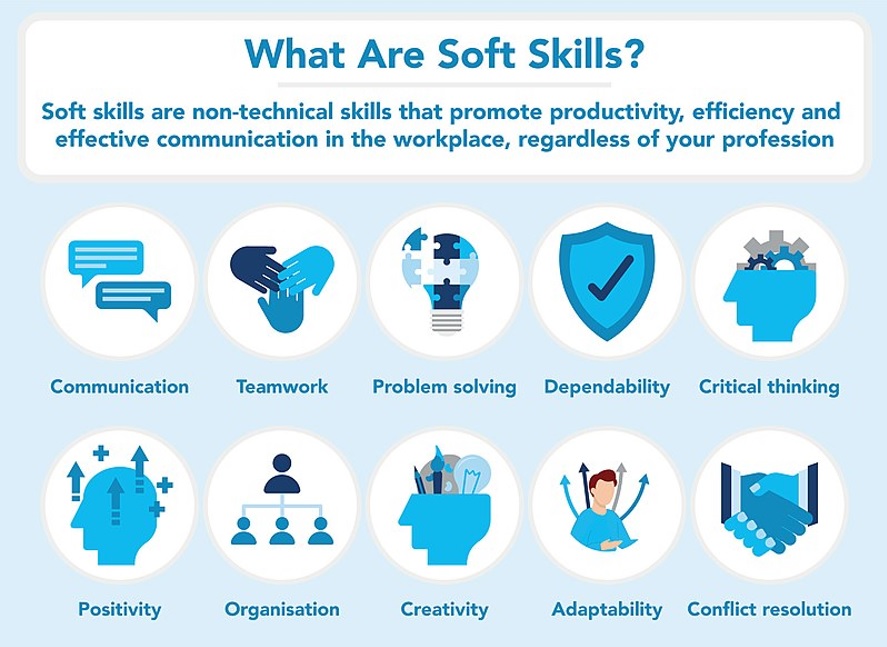10.1 Career Development and Growth
Learning Objectives
By the end of this section, you will be able to:
- Describe the five stages of career development.
- Describe the Plan-Do-Check-Act strategy.
- Compare and contrast hard skills and soft skills.
- Describe strategies for networking.
- Describe strategies for earning promotions at work.
What exactly is career development? It’s a lifelong process in which we become aware of, interested in, knowledgeable about, and skilled in a career. It’s a key part of human development as our identity forms and our life unfolds. Below you will learn about the various stages you will go through as your career develops.
Stages of Career Development
There are five main stages of career development (Super & Jordaan, 1973; Kosine & Lewis, 2008). Each stage correlates with attitudes, behaviors, and relationships we all tend to have at that point and age. As we progress through each stage and reach the milestones identified, we prepare to move on to the next one (Figure 10.1).

Growing
This is a time in early years (4–13 years old) when you begin to have a sense about the future. You begin to realize that your participation in the world is related to being able to do certain tasks and accomplish certain goals
Exploring
This period begins when you are a teenager, extends into your mid-twenties, and may extend later. In this stage you find that you have specific interests and aptitudes. You are aware of your inclinations to perform and learn about some subjects more than others. You may try out jobs in your community or at your school. You may begin to explore a specific career. At this stage, you have some detailed “data points” about careers, which will guide you in certain directions.
Establishing
This period covers your mid-twenties through mid-forties. By now you are selecting or entering a field you consider suitable, and you are exploring job opportunities that will be stable. You are also looking for upward growth, so you may be thinking about an advanced degree.
Maintaining
This stage is typical for people in their mid-forties to mid-sixties. You may be in an upward pattern of learning new skills and staying engaged. But you might also be merely “coasting and cruising” or even feeling stagnant. You may be taking stock of what you’ve accomplished and where you still want to go.
Reinventing
In your mid-sixties, you are likely transitioning into retirement. But retirement in our technologically advanced world can be just the beginning of a new career or pursuit—a time when you can reinvent yourself. There are many new interests to pursue, including teaching others what you’ve learned, volunteering, starting online businesses, consulting, etc.
Keep in mind that your career development path is personal to you, and you may not fit neatly into the categories described above. It’s more common than it has been in the past for people to change careers in their thirties, forties, fifties, and even sixties. Perhaps your socioeconomic background changes how you fit into the schema. Perhaps your physical and mental abilities affect how you define the idea of a “career.” Chance is a factor that plays into everyone’s career path in a way that can’t be predicted or anticipated. You are unique, and your career path can only be developed by you.
Career Development Resources
Career experts say that people will change careers (not to mention jobs) five to seven times in a lifetime. So, your career will likely not be a straight and narrow path. Be sure to set goals and assess your interests, skills and values often. Seek opportunities for career growth and enrichment. And take advantage of the rich set of resources available to you. Below are just a few.
Whether you are a prospective student, a current student, a graduate, or even an employer, you can obtain invaluable career development assistance at your college or university. Campus career centers can support, guide, and empower you in every step of the career development process, from initial planning to achieving lifelong career satisfaction.
Going to college is one of the best steps you can take to prepare for a career. But soon-to-be or recently graduated students are not necessarily guaranteed jobs. Staying educated about strategies for developing your career and finding new jobs will help you manage ongoing transitions. The book The Secret to Getting a Job After College: Marketing Tactics to Turn Degrees into Dollars by Larry Chiagouris was written specifically to help recent grads increase their chances of finding a job right after college. This book speaks to students in all majors and provides tips and tactics to attract the attention of an employer and successfully compete with other candidates to get the job you want.
Career Roadmap
You can use the Career Roadmap, from DePaul University, to evaluate where you are and where you want to be in your career/careers. This roadmap can help you decide if you want to change career paths and can guide you in searching for a new job. The road map identifies the following four cyclical steps:
- Know yourself.
- Explore and choose options.
- Gain knowledge and experience.
- Put it all together: the job search process.
Plan, Do, Check, Act
PDCA (plan–do–check–act) is a four-step strategy for carrying out change. You can use it to evaluate where you are in the career development process and to identify your next steps (Figure 10.2). The strategy is typically used in the business arena as a framework for improving processes and services. But you can think of your career as a personal product you are offering or selling.

- PLAN: What are your goals and objectives? What process will you use to get to your targets? You might want to plan smaller to begin with and test out possible effects. For instance, if you are thinking of getting into a certain career, you might plan to try it out first as an intern or volunteer or on a part-time basis. When you start on a small scale, you can test possible outcomes.
- DO: Implement your plan. Sell your product—which is YOU and your skills, talents, energy, and enthusiasm. Collect data as you go along; you will need it for charting and analyzing in the Check and Act steps ahead.
- CHECK: Look at your results so far. Are you happy with your job or wherever you are in the career development process? How is your actual accomplishment measuring up next to your intentions and wishes? Look for where you may have deviated in your intended steps. For example, did you take a job in another city when your initial plans were for working closer to friends and family? What are the pros and cons? If you like, create a chart that shows you all the factors. With a chart, it will be easier to see trends over several PDCA cycles.
- ACT: How should you act going forward? What changes in planning, doing, and checking do you want to take? The PDCA framework is an ongoing process. Keep planning, doing, checking, and acting. The goal is continuous improvement.
Career Skills
Employers want individuals who have the necessary hard and soft skills to do the job well and adapt to changes in the workplace. Soft skills may be especially in demand today because employers are generally equipped to train new employees in a hard skill, such as new computer software, but it’s much more difficult to teach an employee a soft skill such as developing rapport with coworkers or knowing how to manage conflict.
Hard Skills
Hard skills are concrete or objective abilities that you learn and perhaps have mastered. They are skills you can easily quantify, like using a computer, speaking a foreign language, or operating a machine. You might earn a certificate, a college degree, or other credentials that attest to your hard-skill competencies. Obviously, because of changes in technology, the hard skills required by industries today are vastly different from those required centuries ago (Figure 10.3).

Soft Skills
Soft skills, on the other hand, are subjective skills that have changed very little over time. Such skills might pertain to the way you relate to people; the way you think; or the ways in which you behave—for example, listening attentively, working well in groups, and speaking clearly. Soft skills are sometimes also called transferable skills because you can easily transfer them from job to job or profession to profession without much training.
These skills are transferable because they are positive attributes that are invaluable in practically any kind of work. They also do not require much training from an employer—you have them already and take them with you wherever you go. Soft skills are a big part of your “total me” package.
So, identify the soft skills that show you off the best, and identify the ones that prospective employers are looking for (Figure 10.4). By comparing both sets, you can more directly gear your job search to your strongest professional qualities.

Networking
In the context of career development, networking is the process by which people build relationships with one another for the purpose of helping one another achieve professional goals. Networking involves the exchange information with others. For example:
- You may share business cards, résumés, cover letters, job-seeking strategies, leads about open jobs, information about companies and organizations, and information about a specific field.
- You might also share information about meet-up groups, conferences, special events, technology tools, and social media.
- You might also solicit job “headhunters,” career counselors, career centers, career coaches, an alumni association, family members, friends, acquaintances, and vendors.
Networking can occur anywhere and at any time. In fact, your network expands with each new relationship you establish (Figure 10.5). And the networking strategies you can employ are nearly limitless. With imagination and ingenuity, your networking can be highly successful.

Strategies for Networking
We live in a social world. Almost everywhere you go and anything you do professionally involves connecting with people. It stands to reason that finding a new job and advancing your career entails building relationships with these people. The challenge is figuring out how to do it. What is your first step? Whom do you contact? What do you say? How long will it take? Where do you concentrate efforts? How do you know if your investments will pay off?
The following strategies can be useful tools for networking:
- Create an action plan and use it to think through your career goals and the steps you need to take to meet them. Use the information you learned in Chapter 3 to help you create your action plan.
- Think of your network holistically. You probably know people who can help. Identify those you know personally, academically, and professionally. Let the people in your network know what you are trying to achieve.
- Attend as many events as you can. Put yourself into new situations and become comfortable talking about your career goals and interests.
- Create a professional social media profile. Employers are using LinkedIn and other sites like Indeed to find and screen candidates.
Strategies at College
- Get to know your professors: Communicating with instructors is a valuable way to learn about a career and also get letters of reference if and when needed for a job. When you learn in a virtual environment, it is important to be communicative to build relationships and be memorable. Your instructor can’t provide you with an academic reference if they don’t remember you. Connecting with your instructors might provide you with leads on job openings, internships, or research possibilities. Get to know your instructors. They are a valuable part of your network.
- Network with alumni: Attend alumni events to find people working in your desired field. Search for alums on LinkedIn – they might be willing to do an informational interview or help you in some other way. It is easier to network with people that you share something in common with.
- Network with your learning colleagues: Classmates are an excellent source of information and connections. Many of them may already be working in your desired field.
- Volunteer: Volunteering is an excellent way to meet new people who can help you develop your career, even if the organization you are volunteering with is not in your field. Just by working alongside others and working toward common goals, you build relationships that may later serve you in unforeseen and helpful ways.
- Get an internship: Many organizations offer internship positions to college students. Some of these positions are paid, but often they are not. Paid or not, you gain experience relevant to your career, and you potentially make many new contacts.
- Conduct informational interviews: You may initiate contact with people in your chosen field who can tell you about their experiences of entering the field and thriving in it. Many websites have guidance on how to plan and conduct these interviews.
Strategies at Work
- Join professional organizations: You can meet many influential people at local and national meetings and events of professional and volunteer organizations. Learn about these organizations. See if they have membership discounts for students, or student chapters. Once you are a member, you may have access to membership lists, which can give you prospective access to many new people to network with. Following professional organizations on LinkedIn or other social media allows you to see their content and keep abreast of emerging trends and best practices.
- Get a part-time job: Working full-time may be your ultimate goal, but you may want to fill in some cracks or crevices by working in a part-time job. Invariably you will meet people who can feasibly help with your networking goals. And you can gain good experience along the way, which can also be noted on your résumé. Talk to Career Services to learn more about the possibilities.
- Attend networking events: There are innumerable professional networking events taking place around the world and also online. Find them listed in magazines, community calendars, newspapers, journals, and at the websites of companies, organizations, and associations.
Strategies at Home and Beyond
- Get comfortable and participate in online social media: An explosion of career opportunity awaits you with social media, including LinkedIn, Twitter, Facebook, Instagram, and many more. You will find an extensive list of suggested sites at CareerOneStop. Keep your communication professional at these sites. Follow the guidelines for communication found in the previous section of this chapter. Peruse magazine articles, and if you find one that’s relevant to your field and it contains names of professionals, you can reach out to them to learn more and get job leads. Realize that social media is public and posting pictures of yourself at parties or commenting in an unbecoming way could cost you an opportunity.
- Ask family members and friends, coworkers, and acquaintances for referrals: Do they know others who might help you? You can start with the question “Who else should I be talking to?”
- Use business cards or networking cards: A printed business card can be an essential tool to help your contacts remember you. Creativity can help in this regard, too. Students often design cards themselves and either hand print them or print them on a home printer.
The bottom line with developing professional networks is to cull information from as many sources as possible and use that information in creative ways to advance your career opportunities.
Career Growth
Once you have found a career that interests you and have started on that path, your focus should familiarize yourself with planning strategies used by people who want to further their careers. Each of these involves and requires emotional intelligence skills that you learned about in chapter 5 and throughout the book. Having emotional intelligence skills, as you may recall, is even more important than having a high IQ in the workplace (Goleman, 2005). Knowing yourself and your ability to manage your actions and behaviors is necessary to achieve career success.
Getting Promoted
How to get promoted must be one of the questions managers are asked the most. Often earning a promotion or movement into a higher level is dependent on not only one’s skills and abilities but also certain behaviors. According Siang (2006) there are several characteristics people have that can help them earn a promotion, and these areas fall into one of three categories; plan, attitude, and action:
Plan
- Perform self-analysis. Examining your strengths and weaknesses can help you to improve your work to prepare for a promotion.
- Keep your eye on the goals. What are your work goals? What do you need to do to accomplish them? Developing S.M.A.R.T. goals and an action plan for each goal will help you to achieve them.
Attitude
- Be proud of your work. Put in the necessary effort to complete your work at the highest levels and be proud of what you accomplish.
- Develop your knowledge, skills, and abilities. Do what needs to be done to acquire skills. Take seminars and workshops and attend conferences. Make sure you continually update your skills.
- View challenges as opportunities for growth. Avoid complaining and look at things to overcome as ways to improve your skills but also to show others you are capable of solving problems.
Action
- Understand your role in helping the organization achieve goals. Be a team player to understand what you must do to help the rest of the department and organization achieve.
- Do your best. Take initiative. Look at how you can solve problems or contribute new ideas. But don’t over-extend yourself!
- Go the extra mile. Take the initiative to aid with work or problems that you know how to or think you can solve.
- Do work from the next level up. Continue to do your own work, but try to take on assignments that may be “above your pay grade” or above your normal expected workload. This shows you are capable of the position you want.
Besides understanding the skills, attitudes, and abilities needed for promotion, learning how to handle change is a great way to earn a promotion and obtain career success.
Summary
- There are five stages of career development: growing, exploring, establishing, maintaining, and reinventing.
- The Plan-Do-Check-Act strategy can help you make evaluate your career and know when to make changes in your career.
- Hard skills can be learned in your career, while soft skills are transferable between careers.
- Networking allows you to build relationships with other people who may have skills or other connections to help you be successful in your career.
- Continuously evaluating your own performance and having self-awareness about your knowledge, skills, and abilities in your job can help you work towards getting promoted.
Discussion Questions
- Use the Plan-Do-Check-Act strategy to determine where you are in the career-development process. What can you do to work toward your desired career?
- Which of the top 10 soft skills do you possess? What can you do to help develop the skills you are lacking?
- List three of the networking suggestions that you think you can use to help you advance your career. Which networking suggestions do you think will not be helpful to you? Why?
Remix/Revisions featured in this section
- Editing revisions to tailor the content to the Psychology of Human Relations course.
- Remix of combining Career Development, Skills for a Career and Strategies for Networking (College Succes – Lumen Learning) with Career Growth: Behaviors and Change (Human Relations – Saylor)
- Added images and provided links to locations of images and CC licenses.
- Added doi links to references to comply with APA 7th edition formatting reference manual.
Attributions
CC Licensed Content, Original
Modification, adaptation, and original content. Provided by: Stevy Scarbrough. License: CC-BY-NC-SA
CC Licensed Content Shared Previously
College Success. Authored by: Linda Bruce. Provided by: Lumen Learning. Located at: https://courses.lumenlearning.com/wm-collegesuccess-2/ License: CC BY 4.0
CC Licensed Content Shared Previously
Human Relations. Authored by: Saylor Academy. Located at: https://saylordotorg.github.io/text_human-relations/s05-02-human-relations-personality-an.html License: CC-BY-NC-SA 4.0
References
Goleman, D. (2000). Working with emotional intelligence. Bantam Books.
Kosine, N.R., & Lewis, M.V. (2008). Growth and Exploration: Career Development Theory and Programs of Study. Career and Technical Education Research, 33(8), 227-243. https://doi.org/10.5328/CTER33.3.227
Siang, L. Y. (2006, n.d.). How to get promoted : 9 obvious and often not practiced tips. Career Success for Newbies. Retrieved November 27, 2022 from http://www.career-success-for-newbies.com/how-to-get-promoted.html
Super, D. E., & Jordaan, J. P. (1973). Career development theory. British Journal of Guidance & Counselling, 1(1), 3-16. https://doi.org/10.1080/03069887308259333

